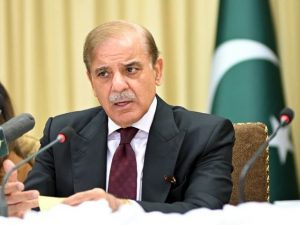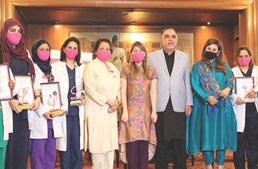The Prime Minister intervenes to break the impasse with the IMF.
Shehbaz encourages Kristalina to relax the requirements regarding the increase in taxes and the cost of energy.

ISLAMABAD:
In an effort to break the impasse, Prime Minister Shehbaz Sharif called International Monetary Fund Managing Director Kristalina Georgieva on Thursday and pleaded with her to loosen the terms pertaining to an increase in energy costs and the implementation of new taxes.
The phone call was conducted four days before the prime minister and IMF chief were scheduled to meet in person at the Geneva Conference to discuss securing concessions from the international lender.
The prime minister requested that the IMF managing director review the need for the introduction of new taxes, according to sources who spoke to The Express Tribune. In order to make up for the yearly circular debt management plan’s deviation of about Rs. 500 billion, he also asked for a waiver of the demand for price increases on energy.
These continue to be the key obstacles to coming to a preliminary agreement for an IMF staff visit to Pakistan. However, they continued, “the government was prepared to slap a flood tax and a windfall income tax on commercial banks.”
The Pakistani side has made a commitment to raise energy rates in the future to counteract any additional departure. It was unclear right away whether the IMF MD had made any compromises.
In the meantime, in an effort to prevent an imminent default, Prime Minister Shehbaz called his Chinese counterpart, Li Keqiang.
Gross official foreign exchange reserves for Pakistan decreased even more, to $5.6 billion. The fact that the prime minister called the head of the IMF shows that the finance ministry has been stuck for more than three months.
Finance Minister Ishaq Dar had earlier voiced the prospect of securing a $3 billion second bailout from Saudi Arabia within days in what appeared to be an alternative to the IMF. He also pledged to raise money through the sale of assets to bolster the critically low foreign exchange reserves. However, because it cannot permanently fix the issue, the Saudi monetary help can only postpone the default.
The government is committed to the IMF programme, according to the finance minister. He continued, “We will not adopt steps that may increase the burden on the average man,” while, at the same time.
The IMF had previously requested a plan to eliminate the additional Rs 500 billion circular debt, increase in energy prices, imposition of new taxes, letting the rupee gain its real value, and achieve the primary budget surplus targets, excluding flood-related expenses – the conditions that will stoke inflation, which is already standing at 25%.
The “International Conference on Climate-Resilient Pakistan,” whose name differs from the one the government previously spelt out, was the subject of a news briefing given by the UN on Thursday.
Ahsan Iqbal, the minister of planning, referred to the event on January 9 as a “Donor’s Conference.” The absence of the word “donor” suggests that Pakistan has little expectation of receiving significant financial assistance from the international community.
It was originally intended for the meeting to set up $8.2 billion in minimum funds, grants, and loans to assist the estimated 33 million Pakistanis devastated by the terrible floods.
The UN Office in Geneva will serve as the venue for the summit, which is being co-hosted by the Pakistani government and the UN. According to Knut Ostby, the country head of the United Nations Development Programme (UNDP) from Geneva, this high-level conference will bring together leaders from the public and private sectors with the goal of generating financial and international support for the communities affected by Pakistan’s devastating floods last year as well as to repair and rebuild damaged infrastructure in a climate-resilient manner.
It is a crucial time because there are only six months until the beginning of the following monsoon, and Osby continued, “We anticipate the donors to offer financial support to Pakistan to begin early reconstruction.”
According to Syed Haider Ali, the additional secretary of the Ministry of Foreign Affairs, who was speaking at the press conference, half of the flood rehabilitation and reconstruction needs will be met by Pakistan from its own resources. These needs were documented in the Resilience Recovery and Rehabilitation and Reconstruction Framework (4RF).
According to the 4RF assessment, Pakistan has estimated a financing shortage of $8.2 billion against the $16.3 billion total required for flood restoration and reconstruction.
It estimated that the federal and provincial budgets could only cover 30%, or $4.9 billion, of the restoration and reconstruction costs. Another 5%, or $814 million, has been projected to come through community support organisations, and 15%, or $2.5 billion, will come via public-private partnership (PPP) models.
The recovery finance model states that the remaining $8.2 billion, or 50%, must come from foreign nations and international creditors. The immediate demands for the next year are projected to cost $6.8 billion out of the total recovery priority cost of $16.3 billion.
In response to a query about why the term donor was removed from the title, the additional secretary responded, “Let us not get into semantics because it obviously contains the aspect of pledges.”
Khalil Hashmi, Pakistan’s ambassador to the UN in Geneva, claimed that throughout the previous two years, numerous exogenous shocks caused problems for other nations as well.
The UNDP national leader responded to a question regarding the world’s lack of reaction to the UN’s flash appeals by stating that the UN only received 30 to 40 percent pledges for each of the two flash appeals.
At the inaugural session, the UN secretary-general will speak. He will then engage in a joint media interview with Prime Minister Shehbaz from a stake-out position.
More than 33 million people were impacted by the floods in Pakistan in 2022, and more than 1,700 people died as a result. Over 2 million homes, 13,000 km of roads, 3,100 km of railroad tracks, and 439 bridges suffered damage or were completely destroyed.
In Sindh, an estimated 240,000 individuals are still without a place to live. In many flood-affected locations throughout Pakistan, the flood waters are still ebbing away.
In Dadu, Kambar, Shahdad Kot, Khairpur, Mirpur Khas, Jamshoro, Sanghar, Umer Kot, Badin, Shaheed Benazirabad and Naushahro Feroze districts in Sindh and Sohbatpur and Jaffarabad districts in Balochistan, standing flood waters are still being recorded.










































